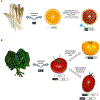Horizontal acquisition of transposable elements and viral sequences: patterns and consequences
- PMID: 29505963
- PMCID: PMC6069605
- DOI: 10.1016/j.gde.2018.02.007
Horizontal acquisition of transposable elements and viral sequences: patterns and consequences
Abstract
It is becoming clear that most eukaryotic transposable elements (TEs) owe their evolutionary success in part to horizontal transfer events, which enable them to invade new species. Recent large-scale studies are beginning to unravel the mechanisms and ecological factors underlying this mode of transmission. Viruses are increasingly recognized as vectors in the process but also as a direct source of genetic material horizontally acquired by eukaryotic organisms. Because TEs and endogenous viruses are major catalysts of variation and innovation in genomes, we argue that horizontal inheritance has had a more profound impact in eukaryotic evolution than is commonly appreciated. To support this proposal, we compile a list of examples, including some previously unrecognized, whereby new host functions and phenotypes can be directly attributed to horizontally acquired TE or viral sequences. We predict that the number of examples will rapidly grow in the future as the prevalence of horizontal transfer in the life cycle of TEs becomes even more apparent, firmly establishing this form of non-Mendelian inheritance as a consequential facet of eukaryotic evolution.
Copyright © 2018 Elsevier Ltd. All rights reserved.
Figures


Similar articles
-
Horizontal transfers of transposable elements in eukaryotes: The flying genes.C R Biol. 2016 Jul-Aug;339(7-8):296-9. doi: 10.1016/j.crvi.2016.04.013. Epub 2016 May 24. C R Biol. 2016. PMID: 27234293 Review.
-
Viruses as vectors of horizontal transfer of genetic material in eukaryotes.Curr Opin Virol. 2017 Aug;25:16-22. doi: 10.1016/j.coviro.2017.06.005. Epub 2017 Jun 30. Curr Opin Virol. 2017. PMID: 28672159 Review.
-
Mosquito genomes are frequently invaded by transposable elements through horizontal transfer.PLoS Genet. 2020 Nov 30;16(11):e1008946. doi: 10.1371/journal.pgen.1008946. eCollection 2020 Nov. PLoS Genet. 2020. PMID: 33253164 Free PMC article.
-
Jumping the fine LINE between species: horizontal transfer of transposable elements in animals catalyses genome evolution.Bioessays. 2013 Dec;35(12):1071-82. doi: 10.1002/bies.201300072. Epub 2013 Sep 3. Bioessays. 2013. PMID: 24003001 Review.
-
A Field Guide to Eukaryotic Transposable Elements.Annu Rev Genet. 2020 Nov 23;54:539-561. doi: 10.1146/annurev-genet-040620-022145. Epub 2020 Sep 21. Annu Rev Genet. 2020. PMID: 32955944 Free PMC article. Review.
Cited by
-
Multiple Invasions of Visitor, a DD41D Family of Tc1/mariner Transposons, throughout the Evolution of Vertebrates.Genome Biol Evol. 2020 Jul 1;12(7):1060-1073. doi: 10.1093/gbe/evaa135. Genome Biol Evol. 2020. PMID: 32602886 Free PMC article.
-
Aphids and Ants, Mutualistic Species, Share a Mariner Element with an Unusual Location on Aphid Chromosomes.Genes (Basel). 2021 Dec 9;12(12):1966. doi: 10.3390/genes12121966. Genes (Basel). 2021. PMID: 34946915 Free PMC article.
-
Global survey of mobile DNA horizontal transfer in arthropods reveals Lepidoptera as a prime hotspot.PLoS Genet. 2019 Feb 1;15(2):e1007965. doi: 10.1371/journal.pgen.1007965. eCollection 2019 Feb. PLoS Genet. 2019. PMID: 30707693 Free PMC article.
-
Characterization of a novel Helitron family in insect genomes: insights into classification, evolution and horizontal transfer.Mob DNA. 2019 May 31;10:25. doi: 10.1186/s13100-019-0165-4. eCollection 2019. Mob DNA. 2019. PMID: 31164927 Free PMC article.
-
Network-based visualisation reveals new insights into transposable element diversity.Mol Syst Biol. 2021 Jun;17(6):e9600. doi: 10.15252/msb.20209600. Mol Syst Biol. 2021. PMID: 34169647 Free PMC article.
References
-
- Craig NL C R: Mobile DNA II. Washington (DC): American Society for Microbiology Press.; 2002.
-
- Chenais B, Caruso A, Hiard S, Casse N: The impact of transposable elements on eukaryotic genomes: from genome size increase to genetic adaptation to stressful environments. Gene 2012, 509:7–15. - PubMed
Publication types
MeSH terms
Substances
Grants and funding
LinkOut - more resources
Full Text Sources
Other Literature Sources

